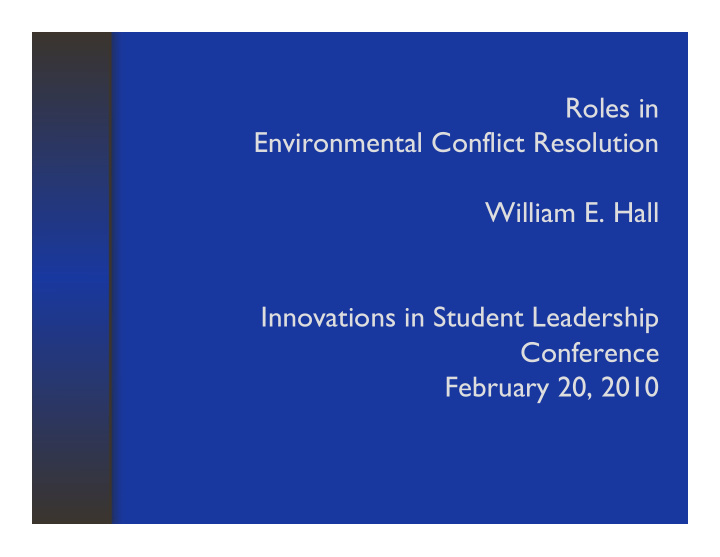



Roles in Environmental Conflict Resolution William E. Hall Innovations in Student Leadership Conference February 20, 2010
What is ECR? • According to Dukes (2004), ECR is an umbrella term for a range of processes • Characteristics: – Direct, face-to-face discussions – Deliberation intended to enhance mutual education and understanding – Inclusion of multiple sectors representing diverse and often conflicting perspectives – Consensus or some variation other than unilateral decision making as the basis for agreements – May or may not have a third party – Environmental issues at stake
Roles • Actors who impact the process of environmental negotiation • The utility of particular roles is context dependent – different roles are relevant depending on the circumstances
Roles in ECR* Party Party Advocate Advocate Neutral Third Party Researcher *Adapted from Laue, 1987 Other
Curle’s Progression of Conflict
Literature on Roles in ECR • Parties • Government Entities • Neutral Third Parties – Mediators and Facilitators
ECR Evaluation Framework ECR ¡deemed ¡appropriate ¡ Appropriate ¡ Agreement ¡is ¡ par/es ¡engaged ¡ reached ¡ Willingness ¡to ¡ collaborate ¡ Case ¡ Number ¡of ¡ Par/es ¡have ¡/me, ¡skills ¡ Par/cipants ¡ Agreement ¡is ¡of ¡ ¡ Context ¡ par/cipants ¡ and ¡resources ¡to ¡engage ¡ effec/vely ¡engaged ¡ high ¡quality ¡ Degree ¡of ¡ case ¡difficulty ¡ Appropriate ¡mediator ¡/ ¡ Working ¡rela/onships ¡ Skills ¡and ¡prac/ces ¡add ¡ improve ¡ value ¡ Relevant ¡high ¡quality ¡ trusted ¡informa/on ¡ integrated ¡ Source: Emerson, Orr, Keyes, and McKnight (2009)
Turning Points Framework* Roles: Party, Direction: Advocate, Toward or Neutral Third Party, Away From Enforcer, More or Less Agreement Researcher, Abrupt and/or Other Type: Procedural Type: Procedural and/or Substantive and/or Substantive PRECIPITANT TURNING POINT CONSEQUENCE *adapted from Druckman (2001, 2004) and Laue (1987)
Findings about Roles in ECR • Internal Roles (parties and advocates) – more likely to precipitate change than external roles • External Roles (neutrals, enforcers, researchers, other) – more likely to precipitate movement toward agreement • Parties – most frequent precipitant of change • Neutral third parties – no more likely than other roles to precipitate change
International Environmental Negotiations • Currently looking at Chasek’s (2001) work on turning points in United Nations environmental negotiations • Despite differences in methods, appears to be some commonality at the beginning and end of the negotiation: – External roles important at the beginning – Parties (and substantive activities) important at the end
Roles at the Beginning and End of Environmental Negotiation First Turning Point: Consideration/Beginning of Negotiation Procedural/ More Procedural/Toward Agreement Abrupt External Precipitant Turning Point Consequence Last Turning Point: Final Agreement/End of Negotiation Substantive/ More Substantive/Toward Agreement Internal Abrupt Precipitant Turning Point Consequence
Discussion • What do mediators/facilitators do? – Important in particular situations (e.g., breaking impasses) or phases (e.g., the beginning)? – Indirect (e.g., coaching) vs. direct assistance? – Not change-related (e.g., setting a climate)? • Why are external roles so important at the beginning of an environmental negotiation? • What are your career options in ECR?
Curle’s Progression of Conflict
References • Andrew, J. S. (2001). Making or breaking alternative dispute resolution? Factors influencing its success in waste management conflicts. Environmental Impact Assessment Review, 21, 23-57. • Buckle, L. G., & Thomas-Buckle, S. R. (1986). Placing environmental mediation in context: Lessons from ‘failed’ mediations. Environmental Impact Assessment Review, 6(1), 55-70. • Chasek, P. (1997). A comparative analysis of multilateral environmental negotiations. Group Decision and Negotiation, 6(5), 437-461. • Consensus Building Institute. (1999). Study on the mediation of land use disputes. Cambridge, MA: Consensus Building Institute. • Curle, A. (1971). Making Peace. London: Tavistock Press • Druckman, D. (2004). Departures in negotiation: Extensions and new directions. Negotiation Journal , 20(2), 185-204. • Druckman, D. (2001). Turning points in international negotiation: A comparative analysis. Journal of Conflict Resolution, 45(4), 519-544. • Dukes, E. F. (2004). What we understand about environmental conflict resolution: An analysis based on empirical research. Conflict Resolution Quarterly, 22(1-2), 191-220. • Emerson, K., Orr, P., Keyes, D., and McKnight, K. (2009). Environmental conflict resolution: Evaluating performance outcomes and contributing factors. Conflict Resolution Quarterly, 27(1), 27-64. • Laue, J. (1987). The emergence and institutionalization of third party roles in conflict. In D. J. D. Sandole & I. Sandole-Staroste (Eds.), Conflict management and problem solving: Interpersonal to international applications (pp. 17-29). New York, NY: New York University Press. • Leach, W. D., & Pelkey, N. W. (2001). Making watershed partnerships work: A review of the empirical literature. Journal of Water Resources Planning and Management, 127 (6), 378-385. • Lederach, J.P. (1998). Building Peace: Sustainable Reconciliation in Divided Societies. Washington, D.C.: U.S. Institute for Peace. • Susskind, L. E., & Consensus Building Institute. (1999). Using assisted negotiation to settle land use disputes: A guidebook for public officials. Cambridge, MA: Lincoln Institute of Land Policy.
Recommend
More recommend